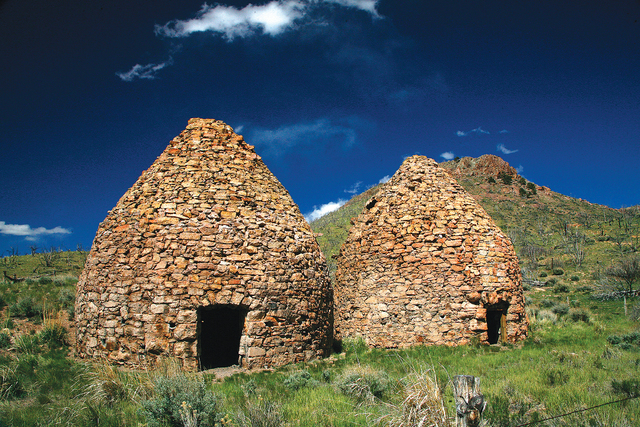Charcoal ovens stoke interest in Nevada’s mining past

Scattered across Nevada, huge beehive-shaped stone structures mark a colorful period in the state’s past. The 30-foot-high charcoal ovens played a vital role in Nevada mining in the late 1800s.
The ovens, which were often built in sets of three, were made to hold 35 cords of wood that was burned to produce charcoal for ore smelters. Usually found in remote locations tied to mining booms, these kilns are often the most enduring evidence of the existence of mining camps and towns that went bust.
The closest kilns for Southern Nevadans are the remains of three structures on the western side of the Spring Mountains, reached by the old road from Pahrump to Wheeler Pass in Humboldt-Toiyabe National Forest. Time and vandalism have left two in ruins, but the U.S. Forest Service has made attempts to stabilize the third. These ovens were stoked with wood cut from surrounding forests and provided charcoal for smelting ore from the nearby Johnnie Mine. Other remains of charcoal kilns in varying states of ruin are found northeast of Panaca off state Route 319 and near Bristol Wells northwest of Pioche.
The best-preserved kilns in Nevada are found in Ward Charcoal Ovens State Historic Park, located off U.S. Highway 93 about a half-hour south of Ely.
The imposing ovens, which were crafted of stone quarried nearby, stand like six sentinels amid the sagebrush near Willow Creek. At nearly 7,000 feet elevation, they command sweeping views across Steptoe Valley toward the high Schell Creek Range.
These kilns once served the mine smelters at nearby Ward, a silver boomtown that was established in 1872. The ovens were erected in 1873 by Swiss-Italian craftsmen, kept stoked by woodcutters camped in nearby forested areas and operated by experienced fire-tenders called carbonari.
When fully stacked and set ablaze, the controlled burn lasted 10 days and yielded 1,750 bushels of charcoal, for which the men were paid 30 cents a bushel.
Visitors to the few ruins of Ward and its cemetery a couple of miles north would probably never guess that the town’s Paymaster Mine once outproduced all others in White Pine County. The ovens remained in use through 1879, when the mines played out. The wooded hills had just about been denuded by that time.
After Ward’s demise, the charcoal ovens survived decades under the protection of local ranchers. Secluded on private property, the ovens were not publicly visited until 1956 when 160 acres were opened under an arrangement with the state. A land trade in 1968 resulted in protection of the site as a state monument the following year. The area was added to the roster of Nevada’s state parks in 1994.
Visitors to Ward Charcoal Ovens State Historic Park today find two roofed day-use areas with grills, water and restrooms and a 15-unit campground with tent and RV sites.
Area streams invite trout anglers. Developed trails within the park are suitable for hiking, horseback treks or mountain biking spring through fall and cross-country skiing and snowshoeing in winter. The area is networked with old mining roads great for off-highway exploration.
Margo Bartlett Pesek’s Trip of the Week column appears on Sundays.












